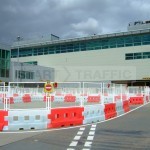When installing our speed bumps, it is important to fit them correctly. This simple guide aims to outline the speed bump fitting process (or installation) to install our speed bumps correctly.
This guide assumes that you are installing a speed bump using one of our Speed Bump Kits.
Things you will require:
A Good Fitting Surface –Before fitting the speed bumps you need to ensure that they are to be mounted on a smooth flat surface. If the surface you are fitting the speed bumps to has any deviations in it, such as pot holes or cracks in the tarmac, then our pot hole repair product VIAFIX can be used to prepare the surface.
